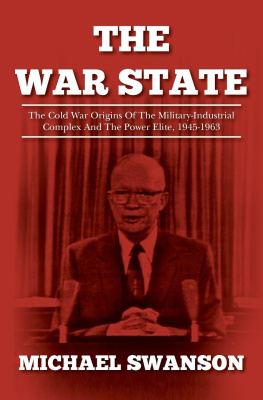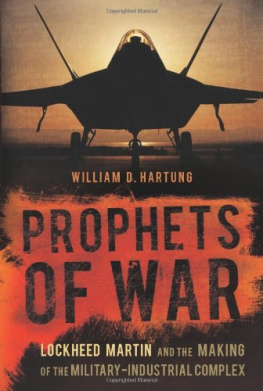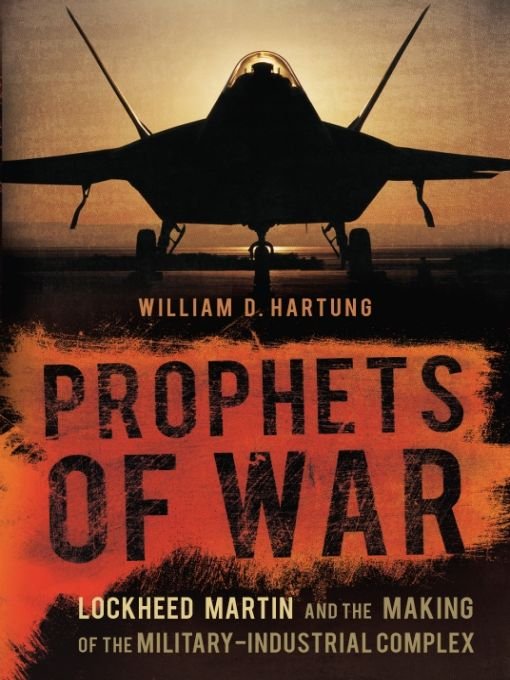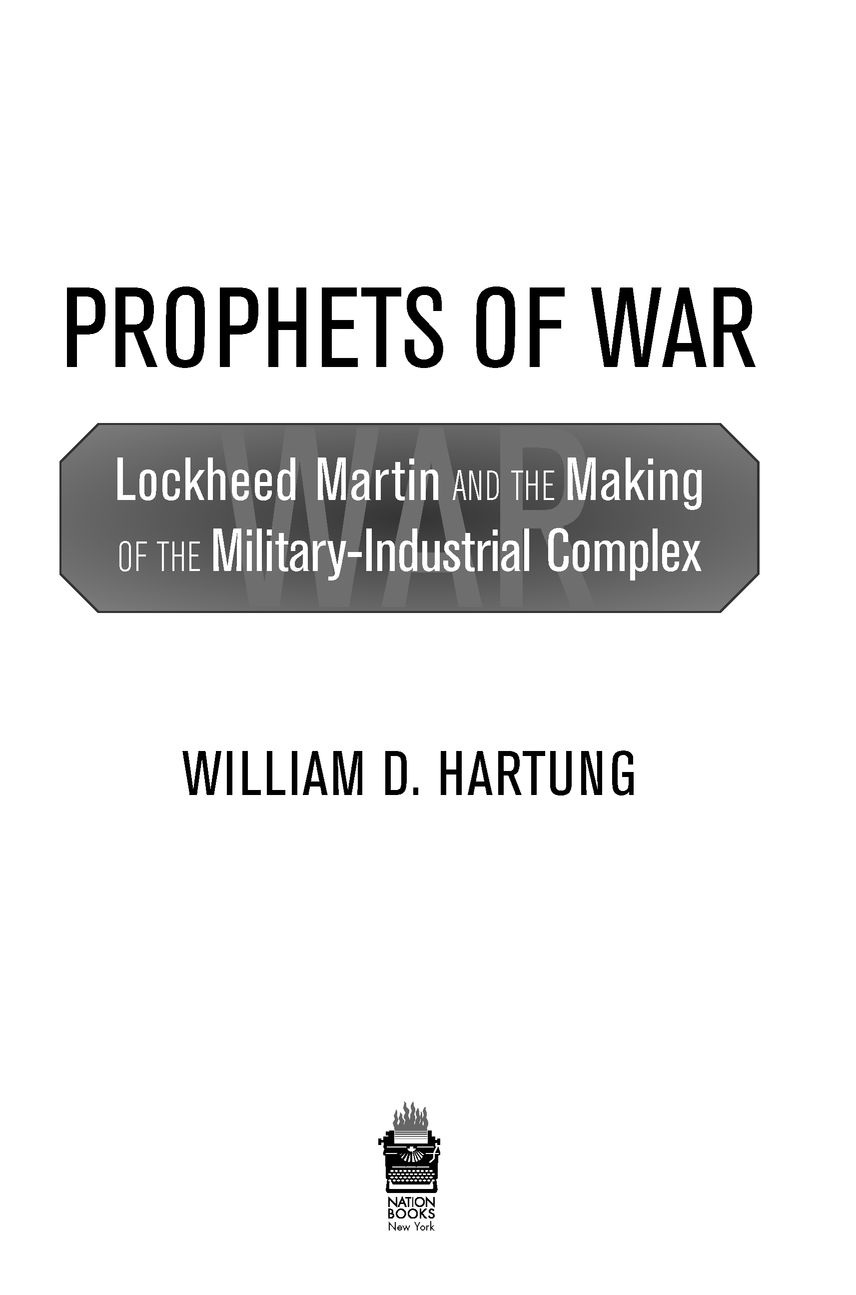Table of Contents
ALSO BY WILLIAM D. HARTUNG
Lessons from Iraq: Avoiding the Next War
(co-edited with Miriam Pemberton)
How Much Are You Making on the War, Daddy?
A Quick and Dirty Guide to War Profiteering in the
George W. Bush Administration
And Weapons for All
To Ruth F. Hartung (1920-1997)
Chapter 1
THE RISE AND FALL OF THE RAPTOR
It is a striking ad. An intimidating combat aircraft soars in the background, with the slogan up front in all capital letters: 300 MILLION PROTECTED, 95,000 EMPLOYED. The adfor Lockheed Martins F-22 Raptor fighter planewas part of the companys last-gasp effort to save one of its most profitable weapons from being terminated, as they say in standard budget parlance. The pro-F-22 ad ran scores of times, in print, on political websites, and even in Washingtons Metro. One writer at the Washington Post joked that at a time when many companies had been cutting back on their advertising budgets, Lockheed Martins barrage of full-page ads in February and March 2009 was the main thing keeping the paper afloat.
When an arms company starts bragging about how many jobs its pet project creates, hold on to your wallet. It often means that the company wants billions of dollars worth of your tax money for a weapon that costs too much, does too little, and may not have been needed in the first place. So it is with the Raptor, which at $350 million per plane is the most expensive combat aircraft ever built. Secretary of Defense Robert Gates has suggested that the F-22 needs to be cut because even with wars raging in Iraq and Afghanistan, it has never been used in combat. In fact, in its first missionflying to Japan for deployment at a U.S. air base therethe plane had technical difficulties and had to land in Hawaii, far short of its final destination.
But Lockheed Martin insists that the Raptors unique capabilities more than justify its huge price tag. For example, did you know that it is the first and only 24/7/365 All-Weather Stealth Fighter? That it has a radar signature approximately the size of a bumblebee? Or that it provides first-look, first-shot, first-kill air dominance capability? Lockheed Martin has a lot to say, and it is serious about selling you its most profitable plane. How else to explain the statement from the F-22 Raptor web page that, when we meet the enemy, we want to win 100-0, not 51-49? It is hard to take this claim seriously. The Raptor has never seen combatand it may never do so given that it was designed to counter a Soviet plane that was never builtso at best the score is zero to zero. But the statement has a grain of truthit describes Lockheed Martins lobbying efforts a whole lot more accurately than its fighter planes mission success rate.
The company never reached its goal of 100-0 support in the Senate, but not for lack of trying. As soon as there was even a whisper of a possibility that the F-22 program would be stopped at only 187 planesabout what the Pentagon wanted, but only half of what the Air Force and Lockheed Martin were striving forthe company started racking up big numbers on its side. By early 2009, months in advance of President Barack Obamas first detailed budget submission to Congresswhich would decide the fate of the F-22Lockheed Martin and its partners in the F-22 project (Pratt & Whitney and Boeing) had lined up forty-four senators and two hundred members of the House of Representatives to sign on to a save the Raptor letter. A similar letter was sent by twelve governorsincluding prominent Democrats like David Paterson of New York and Ted Strickland of Ohio. R. Thomas Buffenbarger, the president of the International Association of Machinists and Aerospace Workers (IAM), also weighed in. The governors letter reads as if it was drafted by Lockheed Martin, which it probably was. We urge you, it begins, to sustain 95,000 jobs by certifying continued production of the F-22 Raptora defense program that is critical to our defense industrial base. After describing it as the worlds only operational 5th Generation fighter (a popular Lockheed Martin description of the Raptor), the letter returns to the jobs argument, asking the President to consider carefully the economic impact of your decision.
At the heart of the lobbying campaign was the mantra of jobs, jobs, jobsjobs in forty-four states, or so the company claimed. Lockheed Martins PR barely bothered to mention that the F-22 is needed to defend the country; that argument was there in the background, but it wasnt the driving force. Lockheeds ads for the plane got more and more specific as time went on, with a series showing people at work on components of the plane with legends like 2,205 F-22 JOBS IN CONNECTICUT; 125 SKILLED MACHINISTS IN HELENA, MONTANA; 50 TITANIUM MANUFACTURING JOBS IN NILES, OHIO; and 30 HYDRAULIC SYSTEMS SPECIALISTS IN MISSISSIPPI. All that was missing were ads for 132 LOBBYISTS, WASHINGTON, D.C.
There was only one problem with this impressive flurry of job claims: They were grossly exaggerated. Utilizing standard techniques that estimate the numbers of jobs generated by different kinds of economic activities, the $4 billion or so per year that the federal government was spending on the F-22 would create less than half as many jobs as Lockheed was claiming. The estimating methodknown as input-output analysiscovers all the bases. It measures every job involved, from directly working on the plane, to working in plants supplying components, to working in the restaurant across the street from the plant where workers spend their wages, and so on.
As for those assertions about where the F-22 jobs were located, when pressed the company refused to back them up. When a USA Today reporter asked for details on the locations of F-22 supplier plants, the company claimed that such information was proprietary and refused to provide it.
But whatever the exact number is, a job is a job is a job. And unlike many government programs whose impact is more dispersed, a military contract generates jobs in large, identifiable locations that can be directly linked to decisions made by the President and the Congress. Add to that the money and lobbying muscle of a company like Lockheed Martin and its a tough combination to beat. Members of Congress dont want to have someone say that they voted against jobs in their state or districtor didnt do enough to keep jobs there. And when a factory scales back or empties out, its hard to miss. The irony is that almost any other form of spending, from education to health care to mass transit to weatherizing buildingseven a tax cutcreates more jobs than military spending. For example, if the F-22 gets funding and spending on other public investments goes down accordingly, there will be a net loss of jobs nationwide. But most of these other jobs are less visible and more widely dispersed, and most importantly, their advocates lack the well-oiled lobbying machine that a firm like Lockheed Martin can bring to bear.
This wasnt the first time the future of the F-22 had been threatened. Back in 1999, the odd couple of the late Representative John Jack Murtha (D-PA) and Representative Jerry Lewis (R-CA) teamed up to withhold production funding from the F-22 in protest over the programs huge cost overruns. There was no immediate question of ending the program, just a pause to get the companysand the Air Forcesattention.











